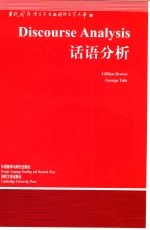图书介绍
话语分析pdf电子书版本下载

- (英)GillianBrown,(英)GeorgeYule著罗选民导读 著
- 出版社: 北京:外语教学与研究出版社
- ISBN:7560020062
- 出版时间:2000
- 标注页数:293页
- 文件大小:12MB
- 文件页数:321页
- 主题词:语言学
PDF下载
下载说明
话语分析PDF格式电子书版下载
下载的文件为RAR压缩包。需要使用解压软件进行解压得到PDF格式图书。建议使用BT下载工具Free Download Manager进行下载,简称FDM(免费,没有广告,支持多平台)。本站资源全部打包为BT种子。所以需要使用专业的BT下载软件进行下载。如 BitComet qBittorrent uTorrent等BT下载工具。迅雷目前由于本站不是热门资源。不推荐使用!后期资源热门了。安装了迅雷也可以迅雷进行下载!
(文件页数 要大于 标注页数,上中下等多册电子书除外)
注意:本站所有压缩包均有解压码: 点击下载压缩包解压工具
图书目录
1 Introduction:linguistic forms and tunctions 1
1.1 The functions of language 1
1.1.1 The transactional view 1
1.1.2 The interactional view 2
1.2.1 Manner of production 4
1.2 Spoken and written language 4
1.2.2 The representation of discourse:texts 5
1.2.3 Written texts 6
1.2.4 Spoken texts 9
Preface by Halliday 9
王宗炎序 10
1.2.5 The relationship between speech and writing 12
导读 13
1.2.6 Differences in form between written and spoken language 14
1.3 Sentence and utterance 19
1.3.1 On data 20
1.3.2 Rules versus regularities 22
1.3.3 Product versus process 23
Preface 25
1.3.4 On context 25
2 The role of context in interpretation 27
2.1 Pragmatics and discourse context 27
Acknowledgements 28
2.1.1 Reference 28
2.1.2 Presupposition 28
Transcription conventions 29
2.1.3 Implicatures 31
2.1.4 Inference 33
2.2 The context of situation 35
2.2.1 Features of context 36
2.2.2 Co-text 46
2.3 The expanding context 50
2.4 The principles of local interpretation and of analogy 58
3 Topic and the representation of discourse content 68
3.1 Discourse fragments and the notion topic 68
3.2 Sentential topic 70
3.3 Discourse topic 71
3.3.1 Topic framework 73
3.3.2 Presupposition pools 79
3.3.3 Sentential topic and the presupposition pool 81
3.4 Relevance and speaking topically 83
3.5 Speaker s topic 87
3.6 Topic boundary markers 94
3.6.1 Paragraphs 95
3.6.2 Paratones 100
3.7 Discourse topic and the representation of discourse content 106
3.8 Problems with the proposition-based representation of discourse content 114
3.9 Memory for text-content:story-grammars 116
3.10 Representing text-content as a network 121
4 Staging and the representation of discourse structure 125
4.1 The linearisation problem 125
4.2 Theme 126
4.3 Thematisation and staging 133
4.3.2 Theme as main character/topic entity 134
4.3.1 Staging 134
4.3.3 Titles and thematisation 139
4.3.4 Thematic structure 140
4.3.5 Natural order and point of view 144
4.3.6 Theme, thematisation and staging 148
5 Information structure 153
5.1 The structure of information 153
5.1.1 Information structure and the notion given/new in intonation 153
5.1.2 Halliday s account of information structure:information units 154
5.1.3 Halliday s account of information structure:tone groups and tonics 155
5.1.4 Identifying the tone group 157
5.1.5 The tone group and the clause 159
5.1.6 Pause-defined units 160
5.1.7 The function of pitch prominence 164
5.2 Information structure and syntactic form 169
5.2.1 Given/new and syntactic form 169
5.2.2 Information structure and sentence structure 176
5.3 The psychological status of givenness 179
5.3.1 What does given mean? 179
5.3.2 A taxonomy of information status 182
5.3.3 The information status taxonomy applied to data 184
5.4 Conclusion 188
6 The nature of reference in text and in discourse 190
6.1 What is text ? 190
6.1.1 Cohesion 191
6.1.2 Endophora 199
6.1.3 Substitution 201
6.2 Discourse reference 204
6.2.1 Reference and discourse representations 206
6.2.2 Referring expressions 208
6.3 Pronouns in discourse 214
6.3.1 Pronouns and antecedent nominals 215
6.3.2 Pronouns and antecedent predicates 216
6.3.3 Pronouns and new predicates 218
6.3.4 Interpreting pronominal reference in discourse 221
7 Coherence in the interpretation of discourse 223
7.1 Coherence in discourse 223
7.2 Computing communicative function 226
7.3 Speech acts 231
7.4 Using knowledge of the world 233
7.5 Top-down and bottom-up processing 234
7.6 Representing background knowledge 236
7.6.1 Frames 238
7.6.2 Scripts 241
7.6.3 Scenarios 245
7.6.4 Schemata 247
7.6.5 Mental models 250
7.7 Determining the inferences to be made 256
7.8 Inferences as missing links 257
7.9 Inferences as non-automatic connections 260
7.10 Inferences as filling in gaps or discontinuities in interpretation 265
7.11 Conclusion 272
References 272
Subject index 284
Author index 286
文库索引 289